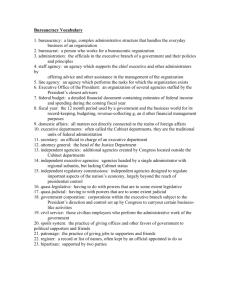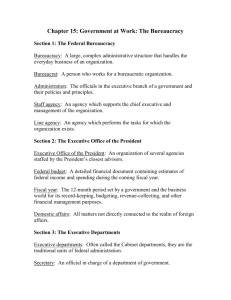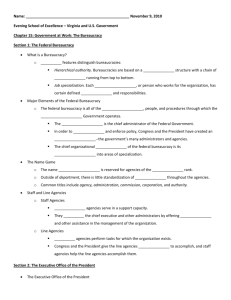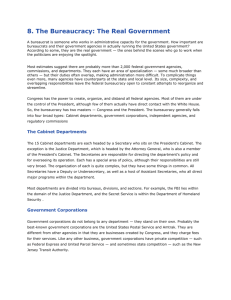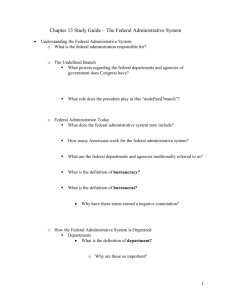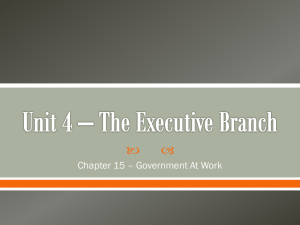Chapter Fifteen
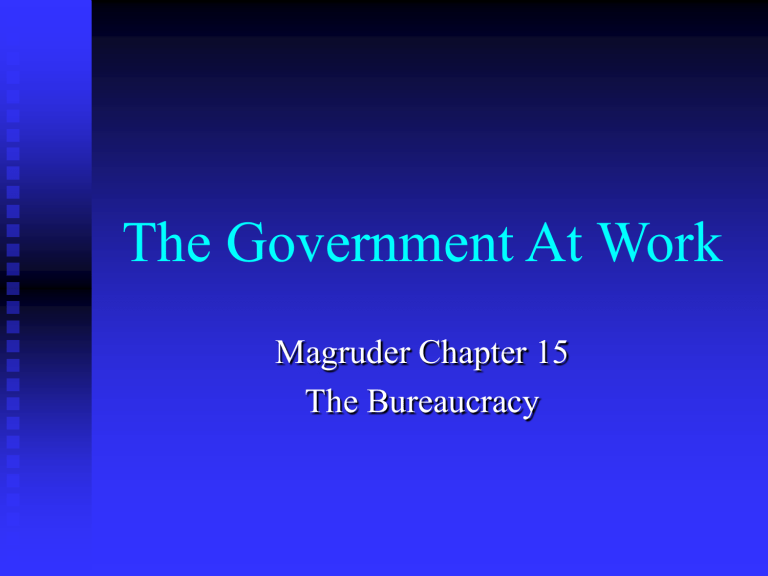
The Government At Work
Magruder Chapter 15
The Bureaucracy
The Federal Bureaucracy
What is a Bureaucracy?
Bureaucracy is based on the principles of hierarchical authority, job specialization, and formal rules
A bureaucracy is a way of organizing people to do work
Major Elements
Nearly all of the bureaucracy of the federal
Government resides in the Executive
Branch of government
The Constitution gives little guidance about the structure of the federal bureaucracy
Major Elements
The bureaucracy is made up of three major groups of administrative agencies: the
Executive Office of the President; the 15
Cabinet Departments; and the Independent
Agencies
The Name Game
The term department is reserved for agencies of cabinet rank
The term agency is used to refer to any governmental body or, more particularly, to a major unit headed by a single administrator of near-cabinet status. The term administration is used in a similar way
The Name Game
The term commission is given to agencies charged with the regulation of business activities. Commissions are headed by varying numbers of top-ranking officers, or commissioners.
The terms corporation and authority are used for agencies that have a board and a manager and that conduct business-like activities.
These terms are not used consistently
Staff and Line
Staff agencies are those agencies that serve in a support capacity by furnishing advice and assistance in the management of an organization
Line agencies are those agencies that actually perform the tasks for which the organization exists
Executive Departments and
Independent Agencies
The Cabinet
The head of each department is known as the Secretary, except for the Justice
Department which is headed by the
Attorney General
Department secretaries are appointed by the
President with the approval of the Senate
Together, the department secretaries serve as the cabinet
What are Independent Agencies?
An independent agency operates outside of the 15 executive departments in the cabinet
Four major reasons explain why these agencies exist outside of the cabinet department structure:
Some agencies are independent because their functions did not fit well into any of the existing departments
What are Independent Agencies?
Some are independent to protect their officials from political pressures
Office of Personnel Management
Social Security Administration
Federal Election Commission
What are Independent Agencies?
Some are independent to make them more responsive to interest-group pressures
Some are independent because of their peculiar and sensitive nature of their functions
What are Independent Agencies?
There are three types of independent agencies: independent executive agencies; independent regulatory commissions; and government corporations
Independent Executive Agencies
Most of the independent agencies fall into this category
They are organized under a single administrator and have subunits that operate on a regional basis
Independent Executive Agencies
Today, there about 150 Independent
Regulatory Agencies
Most are found on the list of agencies on page 383 in the Magruder textbook
Independent Executive Agencies
Includes most of the Independent Agencies
Some are large, multi-million or even billion dollar budgets
GSA, NASA, EPA
Almost the same as the cabinet departments, just do not have cabinet status
Independent Executive Agencies
Others do important work just not as large
Civil Rights Commission
Peace Corps
Federal Election Commission
Independent Executive Agencies
Others act far from the limelight
American Battle Monuments
Commission
Citizen’s Stamp Advisory Committee
Independent Regulatory
Commissions
These commissions are created to regulate important aspects of the nation’s economy
The 10 independent regulatory commissions are largely not under the President’s control
The members of the commissions are appointed by the President and approved by the Senate for long, staggered terms
Independent Regulatory
Commissions
These commissions must be made up from both parties, and members cannot be removed for political reasons
They have quasi-legislative and quasijudicial powers
Used to clarify the laws they must enforce
Act as an arbitrator when questions arise
Independent Regulatory
Commissions
These regulatory bodies possess all three powers – executive, legislative, and judicial
– and are exceptions to the principle of separation of powers
Congress has delegated some of its responsibilities to these agencies to carry out the role congress should have
Independent Regulatory
Commissions
Two major regulatory commissions – the
Civil Aeronautics Board and the Interstate
Commerce Commission – have disappeared in recent years
Government Corporations
These corporations are within the executive branch, and they are under the control of the
President
Their top officers are appointed by the
President with Senate confirmation; all of their employees are public officials
Government Corporations
Examples would be
the FDIC – Federal Deposit Insurance
Corporation
Eximbank -- Export/Import Bank of the
United States
The US Postal Service
National Railroad Passenger Corporation
Government Corporations
Pension Benefit Guaranty Corporation
Tennessee Valley Authority
Government Corporations
Some controversy exists as to whether government corporations are compatible with the democratic government’s requirement that all public agencies be accountable to the public
The Civil Service
Development of the Civil Service
The Beginnings – During the early years of the republic, Presidents tried to fill federal jobs with qualified persons who shared their political views
The Spoils System – Andrew Jackson began the practice of giving government positions to the President’s political supporters
Development of the Civil Service
Jackson defended this policy by saying that any intelligent person can fill any public office
Jackson also maintained that there should be rotation in office so that more people can serve in public office
Long service in office, Jackson believed, would lead to tyranny and inefficiency
Development of the Civil Service
Finally, Jackson claimed that the people are entitled to have the party they elected to power in control of all government offices
The Movement to Reform – Widespread corruption and the assassination of James
Garfield led to the Civil Service Act, or
Pendleton Act, in 1883
Development of the Civil Service
The Pendleton Act
The Pendleton Act made merit the basis for hiring and promotion in federal jobs
The act also required that the federal work force would consist of men and women from every State, with the number from each State bearing a close relationship to that State’s share of the total population
Development of the Civil Service
The Pendleton Act (con)
Veterans received preferred ranking in federal hiring
Civil Service Today
A second goal of civil service reform has been to ensure that the best available people are included in the federal work force
Reorganization – President Carter succeeded in implementing reforms in the civil service system that were intended to make the system more efficient and responsive to merit
Federal Employees and Party Activists
The political activities of federal employees are subject to several limits
Federal employees may not strike
Classified federal employees may not be party activists, run for a partisan office, become officers in a political organization or delegates to a party convention, or raise funds for a political party or any of its candidates
Federal Employees and Party Activists
Pay and Benefits Issues – Minority groups and women are well represented in most federal agencies, but remain at lower-level jobs
